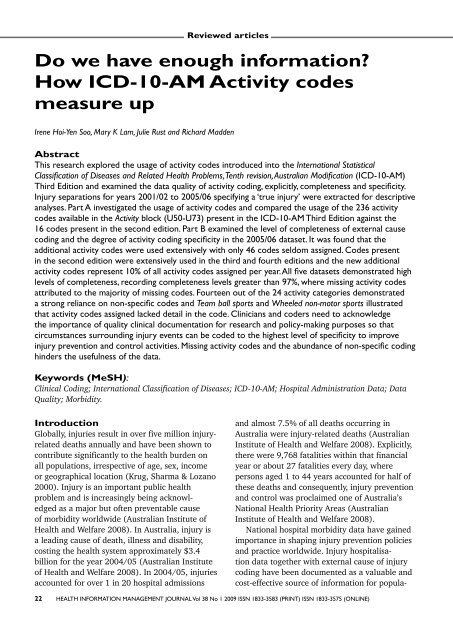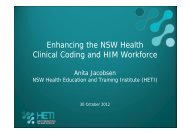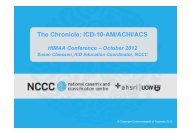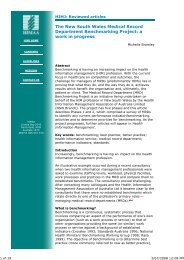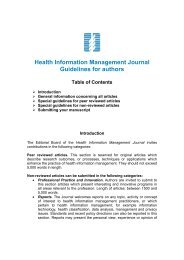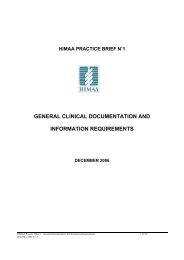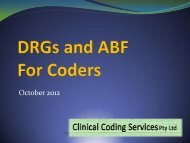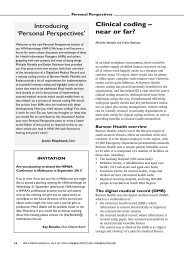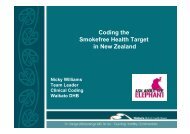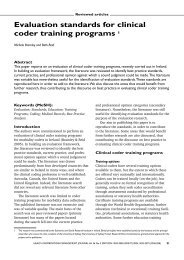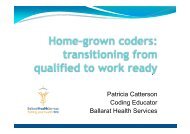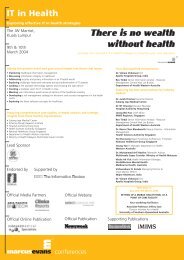How ICD-10-AM Activity codes measure up - Health Information ...
How ICD-10-AM Activity codes measure up - Health Information ...
How ICD-10-AM Activity codes measure up - Health Information ...
Create successful ePaper yourself
Turn your PDF publications into a flip-book with our unique Google optimized e-Paper software.
Reviewed articles<br />
Do we have enough information?<br />
<strong>How</strong> <strong>ICD</strong>-<strong>10</strong>-<strong>AM</strong> <strong>Activity</strong> <strong>codes</strong><br />
<strong>measure</strong> <strong>up</strong><br />
Irene Hoi-Yen Soo, Mary K Lam, Julie Rust and Richard Madden<br />
Abstract<br />
This research explored the usage of activity <strong>codes</strong> introduced into the International Statistical<br />
Classifi cation of Diseases and Related <strong>Health</strong> Problems, Tenth revision, Australian Modifi cation (<strong>ICD</strong>-<strong>10</strong>-<strong>AM</strong>)<br />
Third Edition and examined the data quality of activity coding, explicitly, completeness and specifi city.<br />
Injury separations for years 2001/02 to 2005/06 specifying a ‘true injury’ were extracted for descriptive<br />
analyses. Part A investigated the usage of activity <strong>codes</strong> and compared the usage of the 236 activity<br />
<strong>codes</strong> available in the <strong>Activity</strong> block (U50-U73) present in the <strong>ICD</strong>-<strong>10</strong>-<strong>AM</strong> Third Edition against the<br />
16 <strong>codes</strong> present in the second edition. Part B examined the level of completeness of external cause<br />
coding and the degree of activity coding specifi city in the 2005/06 dataset. It was found that the<br />
additional activity <strong>codes</strong> were used extensively with only 46 <strong>codes</strong> seldom assigned. Codes present<br />
in the second edition were extensively used in the third and fourth editions and the new additional<br />
activity <strong>codes</strong> represent <strong>10</strong>% of all activity <strong>codes</strong> assigned per year. All fi ve datasets demonstrated high<br />
levels of completeness, recording completeness levels greater than 97%, where missing activity <strong>codes</strong><br />
attributed to the majority of missing <strong>codes</strong>. Fourteen out of the 24 activity categories demonstrated<br />
a strong reliance on non-specifi c <strong>codes</strong> and Team ball sports and Wheeled non-motor sports illustrated<br />
that activity <strong>codes</strong> assigned lacked detail in the code. Clinicians and coders need to acknowledge<br />
the importance of quality clinical documentation for research and policy-making purposes so that<br />
circumstances surrounding injury events can be coded to the highest level of specifi city to improve<br />
injury prevention and control activities. Missing activity <strong>codes</strong> and the abundance of non-specifi c coding<br />
hinders the usefulness of the data.<br />
Keywords (MeSH):<br />
Clinical Coding; International Classification of Diseases; <strong>ICD</strong>-<strong>10</strong>-<strong>AM</strong>; Hospital Administration Data; Data<br />
Quality; Morbidity.<br />
Introduction<br />
Globally, injuries result in over five million injuryrelated<br />
deaths annually and have been shown to<br />
contribute significantly to the health burden on<br />
all populations, irrespective of age, sex, income<br />
or geographical location (Krug, Sharma & Lozano<br />
2000). Injury is an important public health<br />
problem and is increasingly being acknowledged<br />
as a major but often preventable cause<br />
of morbidity worldwide (Australian Institute of<br />
<strong>Health</strong> and Welfare 2008). In Australia, injury is<br />
a leading cause of death, illness and disability,<br />
costing the health system approximately $3.4<br />
billion for the year 2004/05 (Australian Institute<br />
of <strong>Health</strong> and Welfare 2008). In 2004/05, injuries<br />
accounted for over 1 in 20 hospital admissions<br />
and almost 7.5% of all deaths occurring in<br />
Australia were injury-related deaths (Australian<br />
Institute of <strong>Health</strong> and Welfare 2008). Explicitly,<br />
there were 9,768 fatalities within that financial<br />
year or about 27 fatalities every day, where<br />
persons aged 1 to 44 years accounted for half of<br />
these deaths and consequently, injury prevention<br />
and control was proclaimed one of Australia’s<br />
National <strong>Health</strong> Priority Areas (Australian<br />
Institute of <strong>Health</strong> and Welfare 2008).<br />
National hospital morbidity data have gained<br />
importance in shaping injury prevention policies<br />
and practice worldwide. Injury hospitalisation<br />
data together with external cause of injury<br />
coding have been documented as a valuable and<br />
cost-effective source of information for popula-<br />
22 HEALTH INFORMATION MANAGEMENT JOURNAL Vol 38 No 1 2009 ISSN 1833-3583 (PRINT) ISSN 1833-3575 (ONLINE)
Reviewed articles<br />
tion-based non-fatal injury surveillance (Langlois<br />
et al. 1995). Therefore, for the data to be useful,<br />
it is imperative that there is complete and<br />
accurate documentation in the medical record<br />
so that hospital morbidity datasets contain high<br />
quality information available for injury prevention<br />
experts and policy makers.<br />
The International Statistical Classification<br />
of Diseases and Related <strong>Health</strong> Problems, Tenth<br />
revision, Australian Modification (<strong>ICD</strong>-<strong>10</strong>-<strong>AM</strong>)<br />
is used nationally to capture morbidity data.<br />
The National Centre for Classification in <strong>Health</strong><br />
(NCCH) is responsible for the development,<br />
introduction and maintenance of <strong>ICD</strong>-<strong>10</strong>-<strong>AM</strong>,<br />
which is revised biennially to ensure currency and<br />
appropriateness for use within clinical practice<br />
in Australia (National Centre for Classification in<br />
<strong>Health</strong> 2004). New editions of <strong>ICD</strong>-<strong>10</strong>-<strong>AM</strong> amend<br />
and clarify the previous edition and address new<br />
and emerging trends based on advice from expert<br />
bodies about themes within the classification<br />
that would increase the value of hospital data<br />
to relevant stakeholders (National Centre for<br />
Classification in <strong>Health</strong> 2004).<br />
There have been significant changes in the<br />
<strong>ICD</strong>-<strong>10</strong>-<strong>AM</strong> framework, particularly Chapter XX<br />
External Causes of Morbidity and Mortality, largely<br />
in the form of additional comprehensive <strong>codes</strong><br />
to capture additional external causes of injury<br />
information. Sports and work-related injuries<br />
are now beginning to be described to a higher<br />
level of detail consistent with the significance of<br />
these activities as a setting for injuries (Harrison<br />
2001). <strong>Activity</strong> <strong>codes</strong> are of particular interest<br />
as they indicate the different types of activities,<br />
such as sports-, leisure- or work-related activities<br />
that were undertaken at time of injury (National<br />
Centre for Classification in <strong>Health</strong> 2004).<br />
Previously located at Y93 with 16 available<br />
<strong>codes</strong>, activity <strong>codes</strong> now occ<strong>up</strong>y an <strong>Activity</strong> block<br />
(U50-U73) within Chapter XX External Causes<br />
of Morbidity and Mortality from third edition<br />
onwards, with 236 mutually exclusive <strong>codes</strong><br />
present (Harrison 2001; National Centre for<br />
Classification in <strong>Health</strong> 2000, 2002). A forward<br />
map of the second edition activity <strong>codes</strong> to third<br />
edition activity <strong>codes</strong> has been provided to detail<br />
the changes in activity <strong>codes</strong> (Table 1).<br />
Table 1: Forward one-to-one map of <strong>ICD</strong>-<strong>10</strong>-<strong>AM</strong><br />
Second Edition activity <strong>codes</strong> to Third Edition<br />
<strong>ICD</strong>-<strong>10</strong>-<strong>AM</strong><br />
<strong>ICD</strong>-<strong>10</strong>-<strong>AM</strong><br />
SECOND<br />
THIRD<br />
EDITION CODE DESCRIPTION EDITION<br />
Y93.00 Football, Rugby U50.03<br />
Y93.01 Football, Australian U50.00<br />
Y93.02 Football, Soccer U50.04<br />
Y93.03 Hockey U51.29<br />
Y93.04 Squash U59.2<br />
Y93.05 Basketball U50.1<br />
Y93.06 Netball U50.39<br />
Y93.07 Cricket U51.1<br />
Y93.08 In-line skating and rollerblading U66.1<br />
Y93.09 Other and unspecifi ed sporting activity U71<br />
Y93.1 While engaged in leisure U72<br />
Y93.2 While working for income U73.09<br />
Y93.3 While engaged in other types of work U73.1<br />
Y93.4 While resting, sleeping, eating or<br />
engaging in other vital activities U73.2<br />
Y93.8 Other specifi ed activity U73.8<br />
Y93.9 Unspecifi ed activity U73.9<br />
In order to provide information that is useful<br />
in aiding injury initiatives, data must be collected<br />
in a consistent fashion. When used in conjunction<br />
with the Australian Coding Standards<br />
(ACS) guidelines, the <strong>ICD</strong>-<strong>10</strong>-<strong>AM</strong> <strong>codes</strong> enable<br />
morbidity data to be collected in a standardised<br />
manner (National Centre for Classification<br />
in <strong>Health</strong> 2004). This ensures consistency and<br />
quality of data nationwide so that comparisons<br />
of these standardised <strong>codes</strong> can be made across<br />
hospitals, states and countries (McKenzie et al.<br />
2006). Despite the presence of these guidelines,<br />
the reliability and integrity of medical record<br />
documentation and coded hospitalisation data<br />
are potentially questionable since data often lack<br />
specificity or are missing. Data quality issues<br />
have been the focus of much research (Mitchell<br />
& Hayen 2006), with previous studies indicating<br />
that the accuracy of injury coding ranges<br />
from 82% to 87% (Langley et al. 2006; LeMier,<br />
Cummings & West 2001; MacIntyre, Ackland &<br />
Chandraraj 1997).<br />
To assess injury data, three particularly<br />
important data attributes relating to coding reliability<br />
must be addressed: accuracy, specificity<br />
and completeness. Accuracy assesses the validity<br />
and correctness of the data. Specificity refers to<br />
HEALTH INFORMATION MANAGEMENT JOURNAL Vol 38 No 1 2009 ISSN 1833-3583 (PRINT) ISSN 1833-3575 (ONLINE) 23
Reviewed articles<br />
the data value being defined to the correct level<br />
of precision or granularity permitted by documentation<br />
in the medical record (AHIMA Data<br />
Quality Task Force 1998). Completeness ensures<br />
that the entire scope of data items are collected<br />
to code all necessary factors; especially, in the<br />
case of injury admissions, information regarding<br />
injury mechanism, place of occurrence (POO)<br />
and activity at time of injury (AHIMA Data<br />
Quality Task Force 1998; National Centre for<br />
Classification in <strong>Health</strong> 2004). Previous studies<br />
have explored the quality of injury coding, especially<br />
the accuracy of injury mechanism <strong>codes</strong><br />
assigned (Hunt et al. 2007; LeMier, Cummings<br />
& West 2001), completeness of external cause<br />
code coding (Lawrence et al. 2007; Coben et al.<br />
2006) and the specificity of external cause coding<br />
(Langley, Davie & Simpson 2007; McKenzie et al.<br />
2006; Finch & Boufous 2008) within <strong>ICD</strong>-<strong>10</strong>-<strong>AM</strong><br />
or its predecessor the International Classification<br />
of Diseases, 9th Revision, Clinical Modification<br />
(<strong>ICD</strong>-9-CM).<br />
Nationally, the ACS is used in conjunction with<br />
the <strong>ICD</strong>-<strong>10</strong>-<strong>AM</strong> and Australian Classification of<br />
<strong>Health</strong> Interventions (ACHI) to provide standards<br />
for clinical coding. It mandates that all records<br />
assigned an injury code must include one or more<br />
of the <strong>ICD</strong>-<strong>10</strong>-<strong>AM</strong> external cause <strong>codes</strong> sequenced<br />
directly after the diagnosis code(s) to which<br />
they relate (National Centre for Classification in<br />
<strong>Health</strong> 2004). The National Hospital Morbidity<br />
Database (NHMD) collects multiple <strong>codes</strong> for<br />
all hospital separations and for this study we<br />
examined injury <strong>codes</strong> in the Principal Diagnosis<br />
(PDx) field only. It is assumed that the injury<br />
PDx correlates with the first code in the injury<br />
mechanism field, place of occurrence field and<br />
activity field. For the purpose of this study, coding<br />
completeness is defined as the presence of the<br />
whole set of external cause <strong>codes</strong> (i.e. injury<br />
mechanism, place of occurrence and activity at<br />
the time of injury [as required for all injury mechanisms<br />
where V01-Y34 is assigned]) (National<br />
Centre for Classification in <strong>Health</strong> 2004). All<br />
of this information is necessary to describe the<br />
injury circumstances.<br />
The ACS also provides guidance to the use of<br />
residual <strong>codes</strong>, stating that the convention used<br />
to indicate ‘Other specified’ or ‘Not elsewhere<br />
classified’ (NEC) in most categories is represented<br />
by the final digit ‘8’, where there is exact information<br />
documented in the medical record for which<br />
there is no unique code available (McKenzie et al.<br />
2006; National Centre for Classification in <strong>Health</strong><br />
2004). A final digit of ‘9’ represents ‘Unspecified’<br />
or ‘Not Otherwise Specified’ (NOS) and is chiefly<br />
used when it is reasonably obvious that no information<br />
is available that would authorise a more<br />
specific assignment elsewhere (National Centre<br />
for Classification in <strong>Health</strong> 2004; McKenzie et<br />
al. 2006). Occasionally, ‘Other specified’ and<br />
‘Unspecified’ are combined into the one code<br />
to form ‘Other and Unspecified’ and because of<br />
this it is difficult to verify whether the use of the<br />
residual category is due to a lack of available<br />
<strong>codes</strong> or lack of clinical documentation (National<br />
Centre for Classification in <strong>Health</strong> 2004;<br />
McKenzie et al. 2006). Subsequently in this study,<br />
specificity will be described in terms of the use<br />
of specific and non-specific <strong>codes</strong>, encompassing,<br />
‘Other specified’, ‘Unspecified’ and ‘Other and<br />
unspecified’.<br />
The authors are not aware of any other<br />
studies that have previously examined the usage<br />
of activity <strong>codes</strong> for injuries and the impact<br />
of activity coding on injury data in countries<br />
utilising the <strong>ICD</strong>-<strong>10</strong>-<strong>AM</strong>. Due to the strong user<br />
demand for the expansion of the activity <strong>codes</strong><br />
and the fact that external cause <strong>codes</strong> provide<br />
the only available information regarding injury<br />
circumstances, it would be useful to determine<br />
the level of usage of the additional activity <strong>codes</strong>.<br />
Aims<br />
The current study sought to examine the effects<br />
of the additional activity <strong>codes</strong> on data quality<br />
within the NHMD. The specific aims of the study<br />
were to:<br />
• ascertain whether additional activity <strong>codes</strong><br />
have a profound impact on the usage of<br />
activity <strong>codes</strong><br />
• examine the effects of activity coding<br />
completeness on injury data<br />
• investigate the usage of activity <strong>codes</strong><br />
being assigned to specific and non-specific<br />
categories.<br />
Methods<br />
Data on hospital separations for years 2001/02<br />
to 2005/06 provided by the Australian Institute<br />
24 HEALTH INFORMATION MANAGEMENT JOURNAL Vol 38 No 1 2009 ISSN 1833-3583 (PRINT) ISSN 1833-3575 (ONLINE)
Reviewed articles<br />
of <strong>Health</strong> and Welfare (AIHW) obtained from<br />
the NHMD were examined. The 2001/02 dataset<br />
consists of approximately 6.4 million separations<br />
and separations have since increased gradually<br />
per annum to 7.3 million separations in 2005/06.<br />
Cases extracted were all injury episodes of<br />
inpatient care provided by acute hospital facilities<br />
in Australia with an <strong>ICD</strong>-<strong>10</strong>-<strong>AM</strong> Principle<br />
Diagnosis (PDx) specifying a ‘true injury’ using<br />
Chapter XIX Injury, poisoning and certain other<br />
consequences of external causes within the<br />
code range S00-T75 and T79. ‘Complications<br />
of surgical and medical care’ result from the<br />
action(s) of persons employed within the<br />
healthcare system and are assigned <strong>codes</strong> from<br />
categories T80 to T88 and are therefore excluded<br />
from the study (Berry & Harrison 2007). The ACS<br />
defines PDx as the ‘diagnosis established after<br />
study to be chiefly responsible for occasioning<br />
an episode of admitted patient care…’ (National<br />
Centre for Classification in <strong>Health</strong> 2004). For this<br />
reason, cases without an injury as a PDx were<br />
excluded from analysis because injury was not<br />
recorded as being the main reason for the hospitalisation.<br />
The complete set of external cause<br />
<strong>codes</strong> were also extracted from the first external<br />
cause, POO and activity fields, that is fields E01,<br />
PL01 and A01 as these <strong>codes</strong> are required by<br />
ACS guidelines to be assigned when an injury<br />
diagnosis is present.<br />
A data extraction program was written using<br />
SPSS. All selected injury records were exported<br />
from the SPSS source file and imported into<br />
Microsoft Access database table and/or Microsoft<br />
Excel where descriptive analyses were performed.<br />
There were 363,376 records that satisfied the<br />
criteria for 2001/02 dataset, 366,890 records for<br />
2002/03 dataset, 372,533 records for 2003/04<br />
dataset, 384,<strong>10</strong>4 records for 2004/05 dataset and<br />
400,019 records for 2005/06 dataset and these<br />
records were extracted for analysis.<br />
Part 1. <strong>Activity</strong> code usage<br />
A. Impact of external cause coding usage<br />
To determine whether the additional activity<br />
<strong>codes</strong> have an impact on external cause coding:<br />
1. Third and fourth edition activity <strong>codes</strong><br />
present in 2002/03 to 2005/06 datasets were<br />
examined separately.<br />
2. Codes present in the second edition and<br />
logically mapped to the third and subsequent<br />
fourth edition (Table 1) were extracted from<br />
2001/02 to 2005/06 datasets and analysed<br />
across the five-year period so that comparisons<br />
of usage can be made. ‘Other <strong>codes</strong>’ denote<br />
<strong>codes</strong> that are available in the third edition<br />
onwards but not in the second edition.<br />
B. <strong>ICD</strong>-<strong>10</strong>-<strong>AM</strong> activity code usage, 2001/02<br />
– 2005/06<br />
To investigate the usage of <strong>ICD</strong>-<strong>10</strong>-<strong>AM</strong> activity<br />
<strong>codes</strong>, data collected on the third edition is made<br />
compatible with the second edition by collapsing<br />
new categories into broader categories available<br />
in the second edition (Berry & Harrison 2007;<br />
National Centre for Classification in <strong>Health</strong> 2004)<br />
Part 2. Data quality<br />
A. Completeness of external cause coding,<br />
2001/02 – 2005/06<br />
External cause coding completeness were<br />
examined for the five-year period and the<br />
presence of the first external cause code, POO<br />
and activity code were evaluated.<br />
B. Specificity of activity <strong>codes</strong>, 2005/06<br />
To assess specificity of activity <strong>codes</strong>, the use of<br />
specific and non-specific <strong>codes</strong> (namely, ‘Other<br />
specified’, ‘Unspecified’ and ‘Other and unspecified’)<br />
were explored for the year 2005/06 only.<br />
The U71 code indicates that the activity was<br />
sports/leisure related but the specific activity<br />
was unknown and U72 indicates the activity<br />
was leisure related and not identified as a sport<br />
(National Centre for Classification in <strong>Health</strong><br />
2004).<br />
C. Usage of non-specific of activity <strong>codes</strong>,<br />
2005/06<br />
In this stage the usage of non-specific activity<br />
<strong>codes</strong> for 2005/06 dataset was examined.<br />
HEALTH INFORMATION MANAGEMENT JOURNAL Vol 38 No 1 2009 ISSN 1833-3583 (PRINT) ISSN 1833-3575 (ONLINE) 25
Reviewed articles<br />
Results<br />
Part 1. <strong>Activity</strong> code usage<br />
A. Impact of external cause<br />
coding usage<br />
1. Impact of additional activity<br />
<strong>codes</strong>, 2002/03 to 2005/06<br />
There are 16 activity <strong>codes</strong><br />
available for selection in <strong>ICD</strong>-<br />
<strong>10</strong>-<strong>AM</strong> Second Edition and<br />
236 activity <strong>codes</strong> available<br />
for selection in <strong>ICD</strong>-<strong>10</strong>-<strong>AM</strong><br />
Third and Fourth Editions.<br />
Within the 2002/03 dataset, 94<br />
separations were coded using<br />
<strong>ICD</strong>-<strong>10</strong>-<strong>AM</strong> Second Edition.<br />
These <strong>codes</strong> were logically<br />
mapped to the <strong>ICD</strong>-<strong>10</strong>-<strong>AM</strong><br />
Third Edition activity <strong>codes</strong> so<br />
that they could be examined.<br />
Across the four-year period,<br />
there are 39 <strong>codes</strong> that are<br />
rarely used (frequency of 5 or<br />
less) (data not shown). Of the<br />
39 <strong>codes</strong> that are rarely used,<br />
16 <strong>codes</strong> are residual categories,<br />
that is Other specified and<br />
Unspecified categories.<br />
The most frequent category<br />
to be repetitively assigned a<br />
code less than 5 times annually<br />
over the four-year period was<br />
Power sports (U62) where 5<br />
of the 7 available <strong>codes</strong> were<br />
infrequently used followed by<br />
Combative sports (U61) where<br />
9 of the 20 <strong>codes</strong> available<br />
within the category were infre-<br />
quently used. Interestingly, 8<br />
out of <strong>10</strong> <strong>codes</strong> available within<br />
Multidiscipline sports (U67)<br />
were also seldom used with 3<br />
<strong>codes</strong> having a frequency of<br />
zero over the four-year period.<br />
Of the 236 <strong>codes</strong> available,<br />
7 <strong>codes</strong> have never been<br />
used since the introduction<br />
of the of <strong>Activity</strong> block<br />
in <strong>ICD</strong>-<strong>10</strong>-<strong>AM</strong> Third Edition,<br />
explicitly Synchronised<br />
swimming (U52.0), Curling<br />
(U55.7), Unspecified aesthetic<br />
sport (U58.9), Winter biathlon<br />
(U67.0), Heptathlon (U67.2),<br />
Modern pentathlon (U67.3)<br />
and Hot air ballooning (U68.6).<br />
Altogether, the 46 <strong>codes</strong><br />
Table 2: Usage of activity <strong>codes</strong> from <strong>ICD</strong>-<strong>10</strong>-<strong>AM</strong> Second Edition<br />
made compatible with later editions, 2001/02 – 2005/06<br />
2001/02 2002/03 2003/04 2004/05 2005/06<br />
CODE DESCRIPTION NO. % NO. % NO. % NO. % NO. %<br />
U50.00 Australian Rules 4911 1.36 3959 1.09 3895 1.05 4335 1.14 4156 1.17<br />
U50.03 Rugby, unspecifi ed 6403 1.78 695 0.19 1424 0.38 1619 0.42 1741 0.49<br />
U50.04 Soccer 3981 1.11 3284 0.90 3285 0.89 3386 0.89 3424 0.96<br />
U50.1 Basketball 1504 0.42 1206 0.33 1204 0.33 1383 0.36 1436 0.40<br />
U50.39 Netball, other and unspecifi ed 1275 0.35 992 0.27 <strong>10</strong>11 0.27 <strong>10</strong>22 0.27 1153 0.32<br />
U51.1 Cricket 1<strong>10</strong>2 0.31 987 0.27 883 0.24 943 0.25 <strong>10</strong>33 0.29<br />
U51.29 Hockey, unspecifi ed 417 0.12 178 0.05 199 0.05 225 0.06 270 0.08<br />
U59.2 Squash 232 0.06 192 0.05 202 0.05 190 0.05 177 0.05<br />
U66.1 In-line skating and rollerblading 1672 0.46 567 0.16 561 0.15 440 0.12 388 0.11<br />
U71 Unspecifi ed sport and<br />
exercise activity 9976 2.77 879 0.24 896 0.24 953 0.25 1251 0.35<br />
U72 Leisure activity,<br />
not elsewhere classifi ed 20135 5.59 8856 2.44 7949 2.15 6999 1.83 6715 1.89<br />
U73.09 While working for income,<br />
unspecifi ed 23616 6.56 7189 1.98 7546 2.04 8019 2.<strong>10</strong> 8739 2.46<br />
U73.1 While engaged in other<br />
types of work 12848 3.57 13554 3.73 13377 3.61 13572 3.55 13719 3.86<br />
U73.2 While resting, sleeping, eating or<br />
engaging in other vital activities 16707 4.64 18179 5.01 18593 5.02 19260 5.04 19890 5.60<br />
U73.8 Other specifi ed activity 82560 22.94 84085 23.16 83617 22.59 76635 20.07 66241 18.64<br />
U73.9 Unspecifi ed activity 172090 47.81 175<strong>10</strong>4 48.23 183897 49.67 200873 52.61 225048 63.33<br />
Other Codes 39193 <strong>10</strong>.80 40433 <strong>10</strong>.92 41272 <strong>10</strong>.81 41767 11.75<br />
Missing 519 0.14 3957 1.09 1235 0.33 704 0.18 671 0.19<br />
Total 359948 <strong>10</strong>0.00 363056 <strong>10</strong>0.00 370207 <strong>10</strong>0.00 381830 <strong>10</strong>0.00 397819 <strong>10</strong>0.00<br />
26 HEALTH INFORMATION MANAGEMENT JOURNAL Vol 38 No 1 2009 ISSN 1833-3583 (PRINT) ISSN 1833-3575 (ONLINE)
Reviewed articles<br />
Table 3: Patterns of <strong>Activity</strong> code usage when injury occurred, 2001/02 to 2005/06<br />
2001/02 2002/03 2003/04 2004/05 2005/06<br />
CODE ACTIVITY NO. % NO. % NO. % NO. % NO. %<br />
U50-U71 While engaged in sports 31473 8.74 36536 <strong>10</strong>.06 38173 <strong>10</strong>.31 39621 <strong>10</strong>.38 40234 <strong>10</strong>.11<br />
U72 While engaged in leisure 20135 5.59 8856 2.44 7949 2.15 6999 1.83 6715 1.69<br />
U73.0 While working for income 23616 6.56 22785 6.28 23366 6.31 24166 6.33 25301 6.36<br />
U73.1 While engaged in other<br />
types of work 12848 3.57 13554 3.73 13377 3.61 13572 3.55 13719 3.45<br />
U73.2 While resting, sleeping, eating or<br />
engaging in other vital activities 16707 4.64 18179 5.01 18593 5.02 19260 5.04 19890 5.00<br />
U73.8 Other specifi ed activity 82560 22.94 84085 23.16 83617 22.59 76635 20.07 66241 16.65<br />
U73.9 Unspecifi ed activity 172090 47.81 175<strong>10</strong>4 48.23 183897 49.67 200873 52.61 225048 56.57<br />
<strong>Activity</strong> code not reported<br />
or missing 519 0.14 3957 1.09 1235 0.33 704 0.18 671 0.17<br />
Total 359948 <strong>10</strong>0.00 363056 <strong>10</strong>0.00 370207 <strong>10</strong>0.00 381830 <strong>10</strong>0.00 397819 <strong>10</strong>0.00<br />
represent nearly one-fifth of<br />
<strong>codes</strong> available for coding but<br />
are seldom assigned where 26<br />
of these <strong>codes</strong> were specified<br />
and 17 were residual <strong>codes</strong>.<br />
2. Usage of <strong>ICD</strong>-<strong>10</strong>-<strong>AM</strong> Second<br />
Edition activity <strong>codes</strong>, 2001/02 to<br />
2005/06<br />
By comparing the <strong>ICD</strong>-<strong>10</strong>-<strong>AM</strong><br />
Second Edition activity <strong>codes</strong><br />
to Third and Fourth editions,<br />
we found that the usage of the<br />
second edition activity <strong>codes</strong> in<br />
2001/02 was much higher in a<br />
majority of cases compared to<br />
the same activities extracted in<br />
2002/03 to 2005/06. The additional<br />
activity <strong>codes</strong> (‘Other<br />
<strong>codes</strong>’) represent a tenth of all<br />
<strong>codes</strong> assigned (Table 2).<br />
B. <strong>ICD</strong>-<strong>10</strong>-<strong>AM</strong> activity code<br />
usage, 2001/02 – 2005/06<br />
Table 3 summarises results<br />
for annual patterns in activity<br />
code usage across the five-year<br />
study period. While engaged in<br />
sports (U50-U71), While resting,<br />
sleeping, eating or engaging in<br />
other vital activities (U73.2),<br />
and Unspecified activity (U73.9)<br />
showed an overall <strong>up</strong>ward<br />
trend, Other specified activity<br />
(U73.8) and missing activity<br />
<strong>codes</strong> declined. Specified<br />
activity <strong>codes</strong> (U50-U73.2)<br />
were assigned in less than<br />
30% of all injury admissions<br />
across the five-year period and<br />
residual (U73.8 and U73.9)<br />
and missing activity <strong>codes</strong><br />
accounted for the majority of<br />
activity <strong>codes</strong> assigned. The<br />
abundance of non-specific<br />
<strong>codes</strong> provides little or no<br />
Frequency<br />
4500<br />
4000<br />
3500<br />
3000<br />
2500<br />
2000<br />
1500<br />
<strong>10</strong>00<br />
500<br />
0<br />
519<br />
3957<br />
information surrounding the<br />
injury circumstances.<br />
Prior to the introduction<br />
of <strong>ICD</strong>-<strong>10</strong>-<strong>AM</strong> Third Edition,<br />
2001/02 data depicted results<br />
fairly consistent with those<br />
of later years except that<br />
While engaged in leisure (U72)<br />
showed higher than average<br />
percentages. Figure 1 illustrates<br />
that across the study period,<br />
missing activity <strong>codes</strong> remained<br />
relatively low apart from<br />
2002/03.<br />
1235<br />
2001/02 2002/03 2003/04 2004/05 2005/06<br />
Year<br />
<strong>Activity</strong> code not reported / Missing<br />
Figure 1: Frequency of missing <strong>Activity</strong> <strong>codes</strong>, 2001/02 to 2005/06<br />
704<br />
671<br />
HEALTH INFORMATION MANAGEMENT JOURNAL Vol 38 No 1 2009 ISSN 1833-3583 (PRINT) ISSN 1833-3575 (ONLINE) 27
Reviewed articles<br />
Part 2. Data quality<br />
A. Completeness of External<br />
Cause coding<br />
The five datasets under study<br />
demonstrated very high levels<br />
of completeness, with all years<br />
recording a completeness level<br />
greater than 97% (data not<br />
shown). Injury mechanism<br />
possessed the lowest frequency<br />
of missing <strong>codes</strong> followed by<br />
POO (data not shown) and<br />
missing activity <strong>codes</strong> comprise<br />
the majority of missing external<br />
cause <strong>codes</strong> highlighted in<br />
Table 3.<br />
Further analysis of the<br />
missing activity <strong>codes</strong> reveals<br />
the PDx, injury mechanism<br />
and POO categories contribute<br />
consistently across the five-year<br />
period although the pattern<br />
varies. For 2004/05 and<br />
2005/06, the high number of<br />
cases of Injury to the head (S00-<br />
S09) and Poisoning by drugs,<br />
medicaments and biological<br />
substances (T36-T50) as the<br />
PDx are responsible for the lack<br />
of activity <strong>codes</strong> (Figure 2).<br />
Injury mechanisms Accidents<br />
(V01-X59) and missing injury<br />
mechanism justified a majority<br />
of missing activity <strong>codes</strong><br />
assigned (Figure 3). Missing<br />
POO <strong>codes</strong> and POO of Home<br />
(Y92.0) were pinpointed as the<br />
bulk of missing activity <strong>codes</strong>,<br />
followed by other POO <strong>codes</strong><br />
for Unspecified place of occurrence<br />
(Y92.9) and Street and<br />
highway (Y92.4) (Figure 4).<br />
Frequency<br />
Frequency<br />
Frequency Frequency<br />
800<br />
700<br />
600<br />
500<br />
400<br />
300<br />
200<br />
<strong>10</strong>0<br />
0<br />
3000<br />
2500<br />
2000<br />
1500<br />
<strong>10</strong>00<br />
500<br />
0<br />
3000<br />
2500<br />
2000<br />
1500<br />
<strong>10</strong>00<br />
Figure 2: Principal Diagnosis <strong>codes</strong> reported<br />
when <strong>Activity</strong> code is missing, 2001/02 to 2005/06<br />
2001/02 2002/03 2003/04 2004/05 2005/06<br />
Year<br />
S00–S09 Injuries to the head<br />
S60–S69 Injuries to the wrist and hand<br />
S80–S89 Injuries to the knee and lower leg<br />
T36–T50 Poisoning by drugs, medicaments<br />
and biological substances<br />
2001/02 2002/03 2003/04 2004/05 2005/06<br />
Year<br />
V01-X59 Accidents<br />
X60-X84 Intentional self-harm<br />
X85-Y09 Assault<br />
Missing<br />
Figure 3: Injury mechanism reported<br />
when <strong>Activity</strong> code is missing, 2001/02 to 2005/06<br />
Y92.0 Home<br />
Y92.4 Street and highway<br />
Y92.9 Unspecified place of occurrence<br />
Missing<br />
500<br />
0<br />
2001/02 2002/03 2003/04 2004/05 2005/06<br />
Year<br />
Figure 4: Place of occurrence reported<br />
when <strong>Activity</strong> code is missing, 2001/02 to 2005/06<br />
28 HEALTH INFORMATION MANAGEMENT JOURNAL Vol 38 No 1 2009 ISSN 1833-3583 (PRINT) ISSN 1833-3575 (ONLINE)
B. Specificity of data across<br />
activity categories, 2005/06<br />
The <strong>Activity</strong> block is organised<br />
into two broad categories,<br />
namely While engaged in sports<br />
or leisure (U50-U72) and While<br />
engaged in other activity (U73).<br />
Within these broad categories<br />
are 24 specific categories from<br />
which there are comprehensive<br />
<strong>codes</strong> to describe the activity at<br />
time of injury and non-specific<br />
residual <strong>codes</strong> to capture information<br />
that cannot be assigned<br />
a more detailed code within the<br />
classification.<br />
Ten of the 24 categories<br />
showed high levels of specificity,<br />
with more than 90% of<br />
cases assigned specific activity<br />
code, therefore these activities<br />
are not reported in Table<br />
4. The remaining 14 <strong>Activity</strong><br />
code categories demonstrated a<br />
Reviewed articles<br />
strong reliance of non-specific<br />
<strong>codes</strong> (Table 4).<br />
C. Usage of non-specific<br />
activity <strong>codes</strong>, 2005/06<br />
Due to the high frequencies of<br />
unspecified <strong>codes</strong> within sports<br />
categories, further examination<br />
of activity categories was<br />
conducted. Team ball sports<br />
(U50) and Wheeled nonmotored<br />
sports (U66) were<br />
chosen for their high levels<br />
of non-specific code coding<br />
of 34.4% and 44.6% respectively.<br />
These categories were<br />
examined in greater detail to<br />
ascertain the usage of residual<br />
categories. Both categories<br />
utilised available specified<br />
<strong>codes</strong> but it was found that the<br />
usage of residual categories<br />
within particular sports, for<br />
example, Football unspecified<br />
(U50.09), Rugby unspecified<br />
(U50.03) and Cycling unspecified<br />
(U66.09) were allocated<br />
frequently in contrast to the<br />
category’s residual <strong>codes</strong><br />
(Figure 5 and 6). Other<br />
specified and unspecified<br />
Team ball sports (U50.8 and<br />
U50.9) and Other specified and<br />
unspecified Wheeled non-motor<br />
sports (U66.8 and U66.9) only<br />
represents 0.18% and 0.38%<br />
of all <strong>codes</strong> assigned to each<br />
category respectively. Football<br />
unspecified (U50.09) and Rugby<br />
unspecified (U50.03) represents<br />
16.9% and 9.98% of all<br />
Team ball sport (U50) injuries.<br />
Cycling unspecified (U66.09)<br />
accounts for 65.55% of all<br />
cycling injuries and 38.15% of<br />
all Wheeled non-motored sport<br />
(U66) injuries.<br />
Table 4: Specificity of data across <strong>Activity</strong> categories, 2005/06<br />
OTHER SPECIFIED<br />
CODE DESCRIPTIONS SPECIFIED OTHER SPECIFIED UNSPECIFIED & UNSPECIFIED TOTAL<br />
n % n % n % n %<br />
U50 Team ball sports 11446 65.63 128 0.73 4712 27.02 1153 6.61 17439<br />
U51 Team bat or stick sports 1551 83.66 32 1.73 271 14.62 1854<br />
U52 Team water sports 7 87.50 1 12.50 8<br />
U53 Boating sports 235 66.20 31 8.73 89 25.07 355<br />
U54 Individual water sports 1878 71.82 200 7.65 537 20.54 2615<br />
U55 Ice and snow sports 771 67.34 43 3.76 331 28.91 1145<br />
U57 Acrobatic sports 230 61.50 47 12.57 97 25.94 374<br />
U61 Combative sports 378 67.14 30 5.33 155 27.53 563<br />
U63 Equestrian activities 1661 89.93 48 2.60 138 7.47 1847<br />
U66 Wheeled non-motor sports 2820 55.42 119 2.34 1955 38.42 194 3.81 5088<br />
U67 Multidiscipline sports 23 79.31 1 3.45 5 17.24 29<br />
U69<br />
U70<br />
Other school-related<br />
recreational activities 434 56.00 91 11.74 250 32.26 775<br />
Other specifi ed sport and<br />
exercise activity 126 12.88 852 87.12 978<br />
U73 Other activity 45394 12.96 7<strong>10</strong>18 20.28 233787 66.76 350199<br />
HEALTH INFORMATION MANAGEMENT JOURNAL Vol 38 No 1 2009 ISSN 1833-3583 (PRINT) ISSN 1833-3575 (ONLINE) 29
Reviewed articles<br />
In addition, further analysis<br />
of Unspecified activity (U73.9)<br />
was conducted to determine<br />
the injury mechanisms responsible<br />
for the high frequency<br />
of this activity code (N =<br />
225,048) (Table 5). Accidents<br />
(V01-X59) accounted for<br />
more than 85% of all injury<br />
mechanisms assigned an<br />
Unspecified activity (U73.9)<br />
code. Falls (W00-W19),<br />
Transport accidents (V01-<br />
V99), Exposure to inanimate<br />
mechanical forces (W20-W49)<br />
and Accidental exposure to other<br />
and unspecified factors (X58-<br />
X59) constituted the majority<br />
of injury mechanisms assigned<br />
an Unspecified activity (U73.9)<br />
code.<br />
66%<br />
Specified Team ball sports<br />
Non-specific Team ball sports<br />
34%<br />
6.61%<br />
16.92%<br />
0.68%<br />
9.98%<br />
Netball, other and unspecified<br />
Football, unspecified<br />
Other specified football<br />
Rugby, unspecified<br />
Figure 5: Specificity of Team ball sports, 2005/06<br />
3.81%<br />
Discussion<br />
<strong>ICD</strong>-<strong>10</strong>-<strong>AM</strong> provides a valuable<br />
means of standardising cause<br />
of injury data on a national<br />
and international level.<br />
Hospital morbidity datasets are<br />
used extensively in Australia<br />
(Berry & Harrison 2007),<br />
New Zealand (Langley et al.<br />
2006), the United Kingdom<br />
(Campbell et al. 2007) and the<br />
United States (Lawrence et al.<br />
2007), and contain information<br />
valuable to injury control<br />
professionals. The availability<br />
of quality external cause<br />
of injury information, and<br />
comprehensive analysis and<br />
reporting of this information<br />
enables identification of significant<br />
injury risks for injury<br />
prevention activities. It establishes<br />
the magnitude of injury<br />
hospitalisations and facilitates<br />
the comparison of external<br />
cause code information across<br />
hospitals, states and countries<br />
55%<br />
45%<br />
Specified Wheeled non-motored sports<br />
Non-specific Wheeled non-motored sports<br />
38.15%<br />
2.24%<br />
Scooter riding, other and unspecified non-motored scooter<br />
Cycling, unspecified<br />
Other specified cycling<br />
Figure 6: Specificity of Wheeled non-motored sports, 2005/06<br />
30 HEALTH INFORMATION MANAGEMENT JOURNAL Vol 38 No 1 2009 ISSN 1833-3583 (PRINT) ISSN 1833-3575 (ONLINE)
Reviewed articles<br />
(Hayen & Mitchell 2006;<br />
McKenzie et al. 2006).<br />
Since its inception in 1998,<br />
NCCH has released a new<br />
edition of <strong>ICD</strong>-<strong>10</strong>-<strong>AM</strong> every<br />
two years. Numerous revisions<br />
to the coding framework<br />
have been made following<br />
the release of the <strong>ICD</strong>-<strong>10</strong>-<strong>AM</strong><br />
First Edition that improves<br />
<strong>up</strong>on each edition. Emerging<br />
trends are addressed to capture<br />
valuable data pertaining to<br />
the circumstances surrounding<br />
injury hospitalisations in<br />
a more specific manner<br />
through the addition of new<br />
<strong>codes</strong> (National Centre for<br />
Classification in <strong>Health</strong> 2004).<br />
The third edition expands<br />
<strong>up</strong>on the 16 activity <strong>codes</strong><br />
available in the second edition<br />
to a comprehensive 236 code<br />
<strong>Activity</strong> block that provides<br />
greater specificity, keeping<br />
abreast of the significance of<br />
these activities as a setting for<br />
injuries (National Centre for<br />
Classification in <strong>Health</strong> 2004).<br />
This study demonstrates that<br />
the expanded <strong>Activity</strong> block<br />
provides a sufficient amount of<br />
<strong>codes</strong> to illustrate the activity<br />
at time of injury. Over 80%<br />
of the <strong>codes</strong> available have<br />
been utilised with only 39<br />
<strong>codes</strong> that are infrequently<br />
used and 7 <strong>codes</strong> never used<br />
since the introduction of the<br />
<strong>Activity</strong> block in <strong>ICD</strong>-<strong>10</strong>-<strong>AM</strong><br />
Third Edition. Combative sports<br />
(U61), Power sports (U62) and<br />
Multidiscipline sports (U67)<br />
were found to be the least used<br />
categories within the <strong>Activity</strong><br />
block and should be examined<br />
to ensure <strong>codes</strong> within the<br />
<strong>Activity</strong> block are current for<br />
clinical practice. The <strong>ICD</strong>-<strong>10</strong>-<br />
<strong>AM</strong> Second Edition activity<br />
<strong>codes</strong> proved to be a valuable<br />
means of assessing the usage<br />
of the additional activity <strong>codes</strong>.<br />
<strong>Activity</strong> <strong>codes</strong> available in<br />
the second edition were used<br />
substantially from 2002/03 to<br />
2005/06 datasets in contrast<br />
to the additional activity <strong>codes</strong><br />
present in third and fourth<br />
editions only, comprised of<br />
approximately <strong>10</strong>% of all<br />
activity <strong>codes</strong> assigned per year.<br />
Furthermore, the research<br />
indicates that there is a high<br />
level of completeness for<br />
external cause coding across<br />
the five-year period, similar to<br />
that reported in other studies<br />
(Coben et al. 2006; MacIntyre,<br />
Table 5: Analysis of injury mechanism responsible for high frequency of Unspecified activity, 2005/06<br />
CODE RANGE DESCRIPTION COUNT %<br />
V01-X59 Accidents 196617 87.37<br />
V01-V99 Transport accidents 36519 18.57<br />
W00-W19 Falls 86849 44.17<br />
W20-W49 Exposure to inanimate mechanical forces 27144 13.81<br />
W50-W64 Exposure to animate mechanical forces 5839 2.97<br />
W65-W74 Accidental drowning and submersion 214 0.11<br />
W75-W84 Other accidental threats to breathing 270 0.14<br />
W85-W99 Exposure to electric current, radiation and<br />
extreme ambient air temperature and pressure 205 0.<strong>10</strong><br />
X00-X09 Exposure to smoke, fire and fl ames 1226 0.62<br />
X<strong>10</strong>-X19 Contact with heat and hot substances 1963 1.00<br />
X20-X29 Contact with venomous animals and plants 2171 1.<strong>10</strong><br />
X30-X39 Exposure to forces of nature 395 0.20<br />
X40-X49 Accidental poisoning by and exposure to noxious substances 4704 2.39<br />
X50-X57 Overexertion, travel and privation 2436 1.24<br />
X58-59 Accidental exposure to other and unspecifi ed factors 26682 13.57<br />
X60-X84 Intentional self-harm 6904 3.07<br />
X85-Y09 Assault 18736 8.33<br />
Y<strong>10</strong>-Y34 Event of undetermined intent 2741 1.22<br />
Missing 50 0.02<br />
Total 225048 <strong>10</strong>0.00<br />
HEALTH INFORMATION MANAGEMENT JOURNAL Vol 38 No 1 2009 ISSN 1833-3583 (PRINT) ISSN 1833-3575 (ONLINE) 31
Reviewed articles<br />
Ackland & Chandraraj 1997). It is concerning that<br />
missing activity <strong>codes</strong> are responsible for the bulk<br />
of missing <strong>codes</strong>. The introduction of the <strong>Activity</strong><br />
block in 2002/03 saw injury data containing<br />
numerous missing activity <strong>codes</strong> (N = 3,957) but<br />
has declined in later years as coders are more<br />
familiar with these <strong>codes</strong> (Figure 1). Results<br />
reveal for years 2004/05 to 2005/06 that Injury<br />
to the Head (S00-S09) and Poisoning by drugs,<br />
medicaments and other substances (T36-T50)<br />
are the PDx responsible for the lack of activity<br />
<strong>codes</strong>. Corresponding injury mechanism Accidents<br />
(V01-X59) and missing injury mechanism justify<br />
the majority of missing activity <strong>codes</strong>. Missing<br />
POO and Home (Y92.0) were the POO where the<br />
majority of these cases happened.<br />
The high levels of missing activity <strong>codes</strong><br />
prove to be a major obstacle to developing injury<br />
prevention policies when the exact circumstances<br />
surrounding injury events are not present. It is<br />
necessary that the specific type of activity be<br />
documented so that effective prevention strategies<br />
can be targeted for specific sports. Langley,<br />
Davie and Simpson (2007) suggest that the relatively<br />
high use of Unspecified activity could be due<br />
to the fact that some hospitals deem this aspect<br />
not as important as injury mechanism. Our results<br />
s<strong>up</strong>port this notion, indicating injury mechanism<br />
<strong>codes</strong> had the lowest amount of missing <strong>codes</strong><br />
compared to POO and activity at time of injury.<br />
The broad <strong>Activity</strong> categories illustrate<br />
reasonable usage of activity <strong>codes</strong> (Table 3).<br />
Unfortunately, the results demonstrate that<br />
activity <strong>codes</strong> assigned lacked precision. The<br />
relatively high use of non-specific sports activity<br />
<strong>codes</strong> within the specified categories such as<br />
Football unspecified (U50.09), Rugby unspecified<br />
(U50.03) and Cycling unspecified (U66.09)<br />
demonstrates activity <strong>codes</strong> are not being<br />
assigned to the highest level of specificity<br />
available in the classification. Similar results were<br />
found in studies focusing on injury mechanism<br />
(Lawrence et al. 2007; McKenzie et al. 2006).<br />
Moreover, our analysis also found that over<br />
the five-year period, specified activity <strong>codes</strong> were<br />
overshadowed by the abundance of non-specific<br />
activity coding. Although there was a decline in<br />
Other specified and missing activity <strong>codes</strong>, this<br />
was made <strong>up</strong> by the ever increasing number<br />
of Unspecified activity (U73.9) <strong>codes</strong> despite<br />
the availability of over 230 activity <strong>codes</strong>. The<br />
results indicate that 47%-56% of activity <strong>codes</strong><br />
were assigned an Unspecified activity code over<br />
the five-year period, a result much higher than<br />
that reported by Finch and Boufous (2008) who<br />
reported an Unspecified activity code of less<br />
than 30% for the state of New South Wales. Our<br />
study shows Falls (W00-W19), Transport accidents<br />
(V01-V99), Exposure to inanimate mechanical<br />
forces (W20-W49) and Accidental exposure to other<br />
and unspecified factors (X58-X59) were the injury<br />
mechanisms that accounted for the majority of<br />
Unspecified activity (U73.9) <strong>codes</strong>.<br />
The findings here s<strong>up</strong>port previous studies in<br />
the United States where Lawrence et al. (2007)<br />
established that the high levels of external cause<br />
coding completeness was achieved by excessive<br />
use of non-specific <strong>codes</strong>. The high level of<br />
non-specific coding reflects a need to acquire<br />
additional information regarding the circumstances<br />
surrounding the injury admission. Also,<br />
coders surveyed in the study by McKenzie and<br />
colleagues (2008) insinuate missing documentation<br />
and missing external cause information<br />
impact significantly on the external cause <strong>codes</strong><br />
allocated.<br />
Causes for the high level of non-specific <strong>ICD</strong>-<br />
<strong>10</strong>-<strong>AM</strong> activity <strong>codes</strong> must be addressed so that<br />
solutions can be developed and implemented<br />
to decrease these data inadequacies. The large<br />
quantity of non-specific activity <strong>codes</strong> offers a<br />
significant amount of non-meaningful information<br />
regarding the specific cause of injuries.<br />
This provides limited benefit for injury prevention<br />
professionals in determining the cause of<br />
the injury, where the results imply that the level<br />
of specificity of injury coding can be improved.<br />
The high percentage of ‘Other specified’ <strong>codes</strong>,<br />
especially within Other specified sport and exercise<br />
activity (U70.8, 87.1%) indicates an area of<br />
potential classification development. The high<br />
proportion of ‘Unspecified’ code represents insufficient<br />
documentation to permit more specific<br />
code assignment (McKenzie et al. 2006) as this<br />
study highlights the insufficient clinical documentation<br />
within the medical records by clinicians.<br />
Unfortunately, clinicians may be unaware of<br />
the level of documentation necessary to detail<br />
the complete circumstances surrounding the<br />
injury event in the medical records because their<br />
32 HEALTH INFORMATION MANAGEMENT JOURNAL Vol 38 No 1 2009 ISSN 1833-3583 (PRINT) ISSN 1833-3575 (ONLINE)
Reviewed articles<br />
priorities lie in the immediate clinical care of the<br />
patient especially if the patient was admitted for<br />
an injury.<br />
Conclusion<br />
Injuries are preventable occurrences and in order<br />
for injury prevention and control organisations to<br />
identify and implement mechanisms to effectively<br />
reduce injury events, access to quality information<br />
is necessary. This determines the degree of<br />
injury hospitalisations and enables the identification<br />
of priority areas for injury prevention<br />
initiatives (Hayen & Mitchell 2006).<br />
In 2002, the NCCH released an <strong>up</strong>date on the<br />
revision of activity <strong>codes</strong>. The expanded classification<br />
provides a variety of mutually exclusive<br />
categories for a large number of specific types<br />
of sport and related activities applicable to the<br />
Australian environment. The results illustrate that<br />
the new <strong>Activity</strong> categories have been used extensively<br />
and that the resultant data were adequate<br />
to warrant detailed analysis of activity code usage<br />
and the quality of external cause code coding, in<br />
particular, specificity and completeness.<br />
The comprehensive nature of <strong>ICD</strong>-<strong>10</strong>-<strong>AM</strong><br />
allows non-specific information to be captured in<br />
residual categories when documentation in the<br />
medical record is insufficient to permit a more<br />
detailed code assignment (Bramley 2005). It is<br />
essential for injury prevention activities that there<br />
is minimal use of these non-specific <strong>codes</strong> to<br />
develop tailored prevention policies and strategies<br />
as the results imply that improvements in the<br />
quality of injury coding are required.<br />
Clinicians and coders need to acknowledge<br />
the importance of quality clinical documentation<br />
for research purposes so that circumstances<br />
surrounding injury events can be coded to the<br />
highest level of detail possible to improve injury<br />
prevention and control initiatives and monitor<br />
injury incidence among Australians nationally.<br />
The results highlighted in this study indicate<br />
that the completeness of external cause coding<br />
is high but found that missing activity <strong>codes</strong> and<br />
non-specific coding hinders the usefulness of the<br />
data to make specific recommendations for injury<br />
initiatives.<br />
Recommendations and further<br />
research<br />
Some recommendations and further research<br />
activities that would aid in improving injury<br />
prevention activities include but are not limited to<br />
the following:<br />
• Medical records/admissions should be validated<br />
by an external coder to determine whether more<br />
appropriate <strong>codes</strong> can be assigned or new <strong>codes</strong><br />
created to accommodate activities assigned to<br />
Other specifi ed sport and exercise activity and<br />
Unspecifi ed activity.<br />
• Improvement of communication among<br />
stakeholders regarding external cause <strong>codes</strong> by<br />
addressing the need and uses of high quality<br />
injury data for injury prevention purposes<br />
would be beneficial.<br />
• Further research and education to examine<br />
state-specific external cause coding accuracy,<br />
specificity and completeness to explore issues<br />
and address the overuse of non-specific <strong>codes</strong><br />
to enable more specific code assignment are<br />
indicated. Efforts to make coding of external<br />
cause of injury required data elements in<br />
medical record forms, electronic patient<br />
records and associated software mandatory<br />
for injury separations (McKenzie et al. 2006)<br />
should be considered.<br />
Acknowledgements<br />
Data for this project were provided by the AIHW<br />
as part of the work program under the AIHW and<br />
NCCH collaboration agreement.<br />
References<br />
AHIMA Data Quality Management Task Force (1998).<br />
Practice Brief: Data Quality Management Model. Journal<br />
of American <strong>Health</strong> <strong>Information</strong> Management Association<br />
69(6): 73-79.<br />
Australian Institute of <strong>Health</strong> and Welfare (2008). Australia’s<br />
health 2008. AIHW Cat. No. AUS 99. Canberra, AIHW.<br />
Berry, J. and Harrison, J. (2007). Hospital separations due to<br />
injury and poisoning, Australia 2003-04. AIHW Cat. No.<br />
INJCAT 88. Adelaide, AIHW.<br />
Bramley, M. (2005). A framework for evaluating health<br />
classifications. <strong>Health</strong> <strong>Information</strong> Management Journal<br />
34(3): 71-83.<br />
Campbell, S.E., Campbell, M.K., Grimshaw, J.M. and Walker,<br />
A.E. (2001). A systematic review of discharge coding<br />
accuracy. Journal of Public <strong>Health</strong> Medicine 23(3): 205-<br />
211.<br />
HEALTH INFORMATION MANAGEMENT JOURNAL Vol 38 No 1 2009 ISSN 1833-3583 (PRINT) ISSN 1833-3575 (ONLINE) 33
Reviewed articles<br />
Coben, J.H., Steiner, C.A., Barrett, M., Merrill, C.T. and<br />
Adamson, D. (2006). Completeness of cause of injury<br />
coding in healthcare administrative databases in the<br />
United States, 2001. Injury Prevention 12(3): 199-201.<br />
Finch, C.F. and Boufous, S. (2008). Do inadequacies in <strong>ICD</strong>-<br />
<strong>10</strong>-<strong>AM</strong> activity coded data lead to underestimates of the<br />
population frequency of sports/leisure injuries? Injury<br />
Prevention 14(3): 202-204.<br />
Harrison, J. (2001). NISU briefing: New External Cause<br />
categories in the third edition of <strong>ICD</strong>-<strong>10</strong>-<strong>AM</strong>. Adelaide,<br />
AIHW.<br />
Hayen, A. and Mitchell, R. (2006). NSW Injury Profile: a<br />
review of injury hospitalisations during 1989-1990 to<br />
2003-2004. Sydney, NSW Injury Risk Management<br />
Research Centre, The University of New South Wales.<br />
Hunt, P.R., Hackman, H., Berenholz, G., McKeown, L., Davis,<br />
L. and Ozonoff, V. (2007). Completeness and accuracy<br />
of International Classification of Disease (<strong>ICD</strong>) external<br />
cause of injury <strong>codes</strong> in emergency department electronic<br />
data. Injury Prevention 13(6): 422-425.<br />
Krug, E.G., Sharma, G.K. and Lozano, R. (2000). The global<br />
burden of injuries. American Journal of Public <strong>Health</strong><br />
90(4): 523-526.<br />
Langley, J.D., Davie, G.S. and Simpson, J.C. (2007). Quality<br />
of hospital discharge data for injury prevention. Injury<br />
Prevention 13(1): 42-44.<br />
Langley, J., Stephenson, S., Thorpe, C. and Davie, G. (2006).<br />
Accuracy of injury coding under <strong>ICD</strong>-9 for New Zealand<br />
public hospital discharges. Injury Prevention 12(1): 58-<br />
61.<br />
Langlois, J.A., Buechner, J.S., O’Connor, E.A., Nacar, E.Q.<br />
and Smith, G.S. (1995). Improving the E-Coding of<br />
Hospitalizations for Injury: do hospital records contain<br />
adequate documentation? American Journal of Public<br />
<strong>Health</strong> 85(9): 1261-1265.<br />
Lawrence, B.A., Miller, T.R., Weiss, H.B. and Spicer, R.S.<br />
(2007). Issues in using state hospital discharge data in<br />
injury control research and surveillance. Accident Analysis<br />
and Prevention 39(2): 319-325.<br />
LeMier, M., Cummings, P. and West, T.A. (2001). Accuracy<br />
of external cause of injury <strong>codes</strong> reported in Washington<br />
State hospital discharge records. Injury Prevention 7(4):<br />
334-338.<br />
MacIntyre, C.R., Ackland, M.J. and Chandraraj, E.J. (1997).<br />
Accuracy of injury coding in Victorian hospital morbidity<br />
data. Australian and New Zealand Journal of Public <strong>Health</strong><br />
21(7): 779-783.<br />
McKenzie, K., Enraght-Moony, E., Harding, L., Walker, S.,<br />
Waller, G. and Chen, L. (2008). Coding external causes<br />
of injuries: problems and solutions. Accident Analysis and<br />
Prevention 40(2): 714-718.<br />
McKenzie, K., Harding, L.F., Walker, S.M., Harrison, J.E.,<br />
Enraght-Moony, E.L., and Waller, G.S. (2006). The quality<br />
of cause-of-injury data: where hospital records fall down.<br />
Australian and New Zealand Journal of Public <strong>Health</strong><br />
30(6): 509-513.<br />
Mitchell, R. and Hayen, A. (2006). Sport- or leisure-related<br />
injury hospital admissions: Do we need to get more out<br />
of being struck? Journal of Science and Medicine in Sport<br />
9(6): 498-505.<br />
National Centre for Classification in <strong>Health</strong> (2000). <strong>ICD</strong>-<strong>10</strong>-<br />
<strong>AM</strong>. 2 nd ed. Sydney, National Centre for Classification in<br />
<strong>Health</strong>.<br />
National Centre for Classification in <strong>Health</strong> (2002). <strong>ICD</strong>-<strong>10</strong>-<br />
<strong>AM</strong>. 3 rd ed. Sydney, National Centre for Classification in<br />
<strong>Health</strong>.<br />
National Centre for Classification in <strong>Health</strong> (2004). <strong>ICD</strong>-<strong>10</strong>-<br />
<strong>AM</strong>. 4 th ed. Sydney, National Centre for Classification in<br />
<strong>Health</strong>.<br />
Irene Hoi-Yen Soo BAppSc(HIM)(Hons)<br />
Research Student<br />
Discipline of <strong>Health</strong> Informatics<br />
Faculty of <strong>Health</strong> Sciences<br />
The University of Sydney<br />
Lidcombe NSW 1825<br />
AUSTRALIA<br />
Corresponding author<br />
Mary K Lam BA(Hons), MHIM, PhD<br />
Lecturer<br />
Discipline of <strong>Health</strong> Informatics<br />
Faculty of <strong>Health</strong> Sciences<br />
The University of Sydney<br />
PO Box 170<br />
Lidcombe NSW 1825<br />
AUSTRALIA<br />
Tel: +61 2 9351 9570<br />
Fax: +61 2 9351 9672<br />
email: m.lam@usyd.edu.au<br />
Julie Rust BAppSc(HIM)<br />
Project Offi cer<br />
National Centre for Classifi cation in <strong>Health</strong><br />
Faculty of <strong>Health</strong> Sciences<br />
The University of Sydney<br />
PO Box 170<br />
Lidcombe NSW 1825<br />
AUSTRALIA<br />
Richard Madden PhD<br />
Professor and Director<br />
National Centre for Classifi cation in <strong>Health</strong><br />
Faculty of <strong>Health</strong> Sciences<br />
The University of Sydney<br />
PO Box 170<br />
Lidcombe NSW 1825<br />
AUSTRALIA<br />
•<br />
34 HEALTH INFORMATION MANAGEMENT JOURNAL Vol 38 No 1 2009 ISSN 1833-3583 (PRINT) ISSN 1833-3575 (ONLINE)
IF IT MOVES, WE WILL TRACK IT<br />
Records, assets and patients<br />
Introducing a unique RFID<br />
system for the tracking of<br />
record, asset and patient<br />
movement.<br />
> Fully compliant with all Standards<br />
> Cost-effective RFID tags<br />
> Discreet readers<br />
> High volume, multi-directional<br />
read capability<br />
> “Real time” recording<br />
> Flexibility<br />
RFID (Radio Frequency IDentification) technologies have been in use for over 50 years and are<br />
encountered daily in such areas as retail security, libraries, vehicle and animal tracking etc. FILE Technology<br />
has now utilized the full potential of this technology as a tracking mechanism for the movement of records,<br />
assets and people. Our system can be installed at an extremely low cost and provides immediate and<br />
accurate information.<br />
For more information, call us on 1300 306 407<br />
or access our demonstration videos at www.filetech.com.au<br />
FILE Technology is a member of the FILE Gro<strong>up</strong> of Companies.


